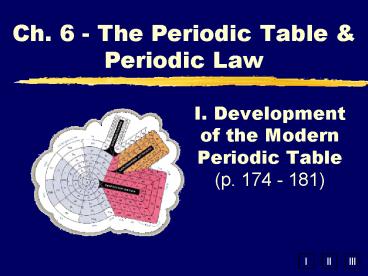Ch. 6 - The Periodic Table - PowerPoint PPT Presentation
1 / 24
Title:
Ch. 6 - The Periodic Table
Description:
Ch. 6 - The Periodic Table & Periodic Law I. Development of the Modern Periodic Table (p. 174 - 181) A. Mendeleev Dmitri Mendeleev (1869, Russian) Organized elements ... – PowerPoint PPT presentation
Number of Views:79
Avg rating:3.0/5.0
Title: Ch. 6 - The Periodic Table
1
I. Development of the Modern Periodic Table(p.
174 - 181)
- Ch. 6 - The Periodic Table Periodic Law
2
A. Mendeleev
- Dmitri Mendeleev (1869, Russian)
- Organized elements by increasing atomic mass
- Elements with similar properties were grouped
together - There were some discrepancies
3
A. Mendeleev
- Deduced elements existed, but were undiscovered
elements, their properties could be predicted
4
B. Moseley
- Henry Moseley (1913, British)
- Organized elements by increasing atomic number
- Resolved discrepancies in Mendeleevs arrangement
- This is the way the periodic table is arranged
today!
5
C. Modern Periodic Table
- Group (Family)
- Period
6
1. Groups/Families
- Vertical columns of periodic table
- Each group contains elements with similar
chemical physical properties (same amount of
valence electrons in each column) - 2 numbering systems exist
- Groups I through VIII with ea. followed by A
or B - A groups are Main Group Elements (sp electrons)
- B groups are Transition Elements (d electrons)
- Numbered 1 to 18 from left to right
7
2. Periods
- Horizontal rows of periodic table
- Periods are numbered top to bottom from 1 to 7
- Elements in same period have similarities in
energy levels, but not properties
8
3. Blocks
- Main Group Elements
- Transition Metals
- Inner Transition Metals
9
3. Blocks
Overall Configuration
10
II. Classification of theElements(pages
182-186)
- Ch. 6 - The Periodic Table
11
A. Metallic Character
- Metals
- Nonmetals
- Metalloids
12
1. Metals
- Good conductors of heat and electricity
- Found in Groups 1 2, middle of table in 3-12
and some on right side of table - Have luster, are ductile and malleable
- Metallic properties increase as you go from left
to right across a period
13
a. Alkali Metals
- Group 1(IA)
- 1 Valence electron
- Very reactive, form metal oxides
(ex Li2O) - Electron configuration
- ns1
- Lowest melting points
- Form 1 ion Cations
- Examples Li, Na, K
14
b. Alkaline Earth Metals
- Group 2 (IIA)
- 2 valence electrons
- Reactive (not as reactive as alkali metals) form
metal oxides (ex MgO) - Electron Configuration
- ns2
- Form 2 ions
- Cations
- Examples Be, Mg, Ca, etc
15
c. Transition Metals
- Groups 3 12 (IB VIIIB)
- Reactive (not as reactive as Groups 1 or 2), can
be free elements - Highest melting points
- Electron Configuration
- ns2(n-1)dx where x is column in d-block
- Form variable valence state ions
- Always form Cations
- Examples Co, Fe, Pt, etc
16
3. Metalloids
- Sometimes called semiconductors
- Form the stairstep between metals and nonmetals
- Have properties of both metals and nonmetals
- Examples B, Si, Sb, Te, As, Ge, Po, At
17
2. Nonmetals
- Not good conductors
- Usually brittle solids or gases (1 liquid Br)
- Found on right side of periodic table AND
hydrogen - Hydrogen is its own group, reacts rapidly with
oxygen other elements (has 1 valence electron)
18
Nonmetal Groups/Families
- Boron Group IIIA typically 3 valence electrons,
also mix of metalloids and metals - Carbon Group IVA typically 4 valence electrons,
also has metal and metalloids - Nitrogen Group VA typically 5 valence electrons,
also has metals metalloids - Oxygen Group VIA typically 6 valence electrons,
also contains metalloids
19
a. Halogens
- Group 17 (VIIA)
- Very reactive
- Electron configuration
- ns2np5
- Form 1- ions 1 electron short of noble gas
configuration - Typically form salts (NaCl)
- Anions
- Examples F, Cl, Br, etc
20
b. Noble Gases
- Group 18 (VIIIA)
- Unreactive, inert, noble, stable
- Electron configuration
- ns2np6 full energy level
- Have an octet or 8 valence e-
- Have a 0 charge, no ions
- Helium is stable with 1s2, a duet
- Examples He, Ne, Ar, Kr, etc
21
B. Chemical Reactivity
- Metals
- Period - reactivity decreases as you go from left
to right across a period. Group - reactivity
increases as you go down a group - Non-metals
- Period - reactivity increases as you go from the
left to the right across a period. Group -
reactivity decreases as you go down the group.
22
C. Valence Electrons
- Valence Electrons
- e- in the outermost s p energy levels
- Stable octet filled s p orbitals (8e-) in one
energy level
23
C. Valence Electrons
- You can use the Periodic Table to determine the
number of valence electrons - Each group has the same number of valence
electrons - Group A of valence e- (except He)
24
D. Lewis Diagrams
- Also called electron dot diagrams
- Dots represent the valence e-
- Ex Sodium
- Ex Chlorine
Lewis Diagram for Oxygen































